Strategic Analysis and Innovation for Marks & Spencer (M&S) Retailer
VerifiedAdded on 2020/06/05
|10
|2853
|50
Report
AI Summary
This report presents a strategic analysis of Marks & Spencer (M&S), a multinational retailer. It begins with an introduction outlining the importance of internal strengths and weaknesses, and external factors. Task 1 includes a SWOT analysis of M&S, examining its strengths, weaknesses, opportunities, and threats. It also utilizes the VRIN criteria and value chain analysis to assess internal resources and capabilities. The report then explores key drivers of change in the external environment using PESTLE analysis, followed by an application of Porter's Five Forces to assess competitive dynamics. Task 2 focuses on strategic options for entrepreneurial opportunities, discussing Porter's generic strategies, the Bowman strategy clock, and the Ansoff matrix. The report concludes by selecting cost leadership and diversification as suitable strategies for M&S to enhance its market share and profitability, offering high-quality products at affordable prices and expanding product offerings to its current market.
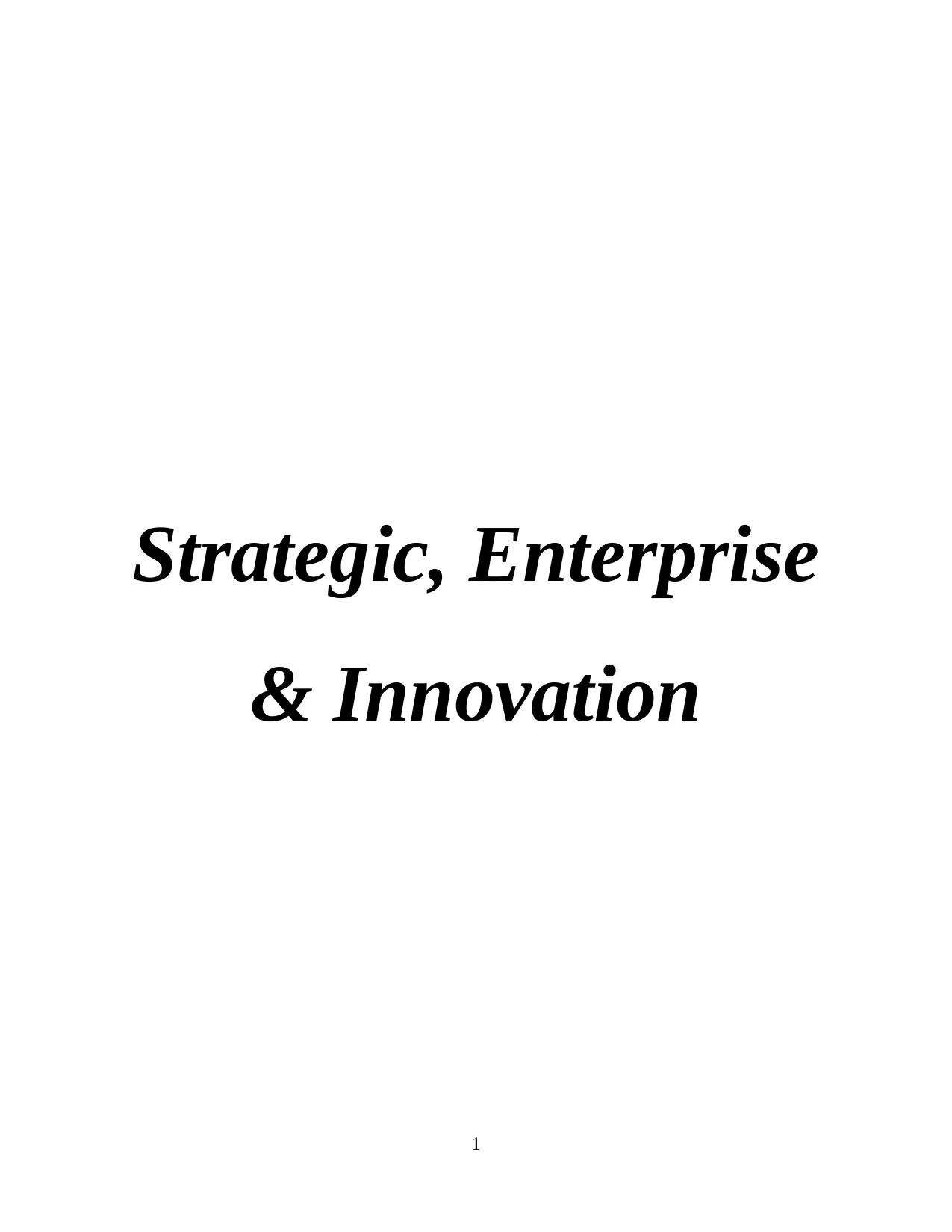
Strategic, Enterprise
& Innovation
1
& Innovation
1
Paraphrase This Document
Need a fresh take? Get an instant paraphrase of this document with our AI Paraphraser
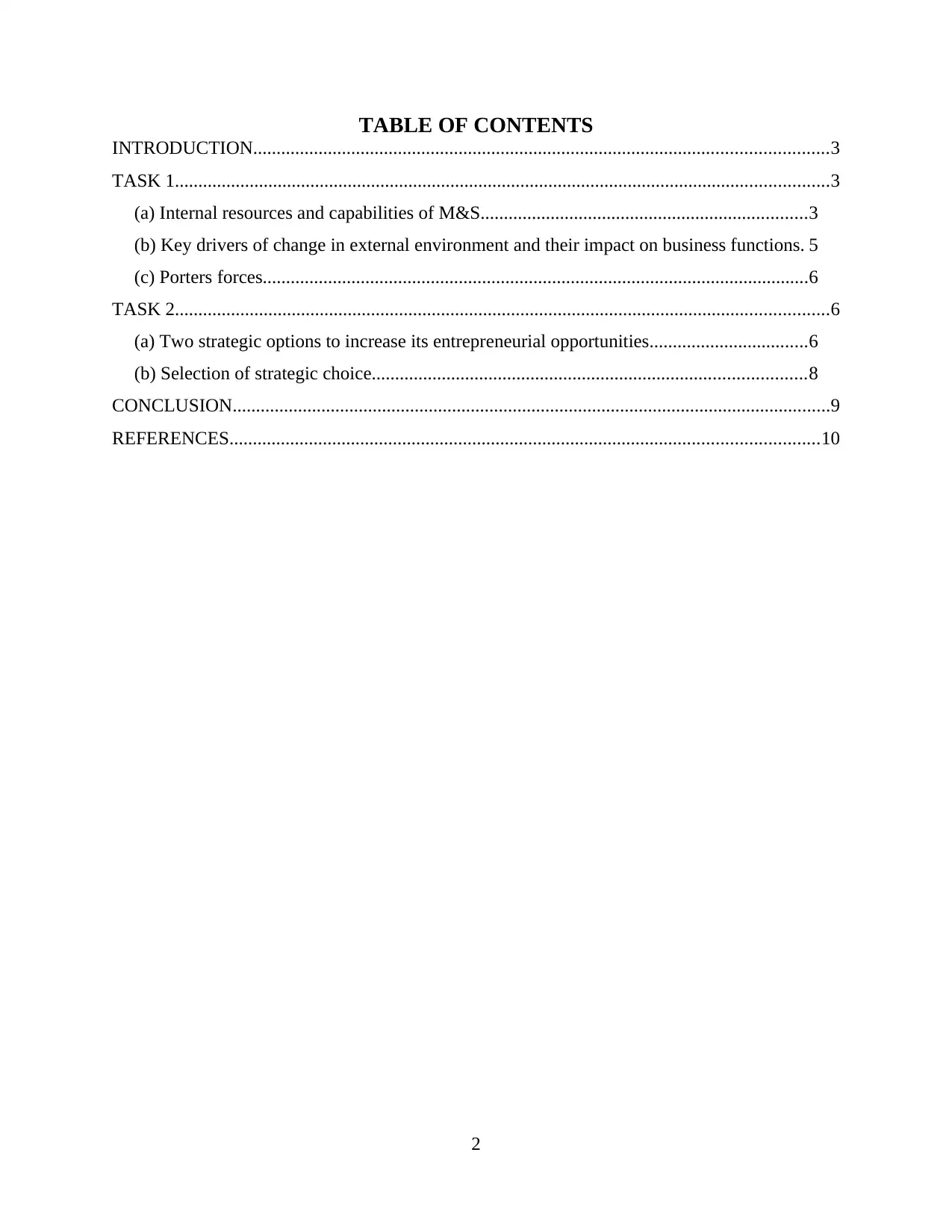
TABLE OF CONTENTS
INTRODUCTION...........................................................................................................................3
TASK 1............................................................................................................................................3
(a) Internal resources and capabilities of M&S......................................................................3
(b) Key drivers of change in external environment and their impact on business functions. 5
(c) Porters forces.....................................................................................................................6
TASK 2............................................................................................................................................6
(a) Two strategic options to increase its entrepreneurial opportunities..................................6
(b) Selection of strategic choice.............................................................................................8
CONCLUSION................................................................................................................................9
REFERENCES..............................................................................................................................10
2
INTRODUCTION...........................................................................................................................3
TASK 1............................................................................................................................................3
(a) Internal resources and capabilities of M&S......................................................................3
(b) Key drivers of change in external environment and their impact on business functions. 5
(c) Porters forces.....................................................................................................................6
TASK 2............................................................................................................................................6
(a) Two strategic options to increase its entrepreneurial opportunities..................................6
(b) Selection of strategic choice.............................................................................................8
CONCLUSION................................................................................................................................9
REFERENCES..............................................................................................................................10
2
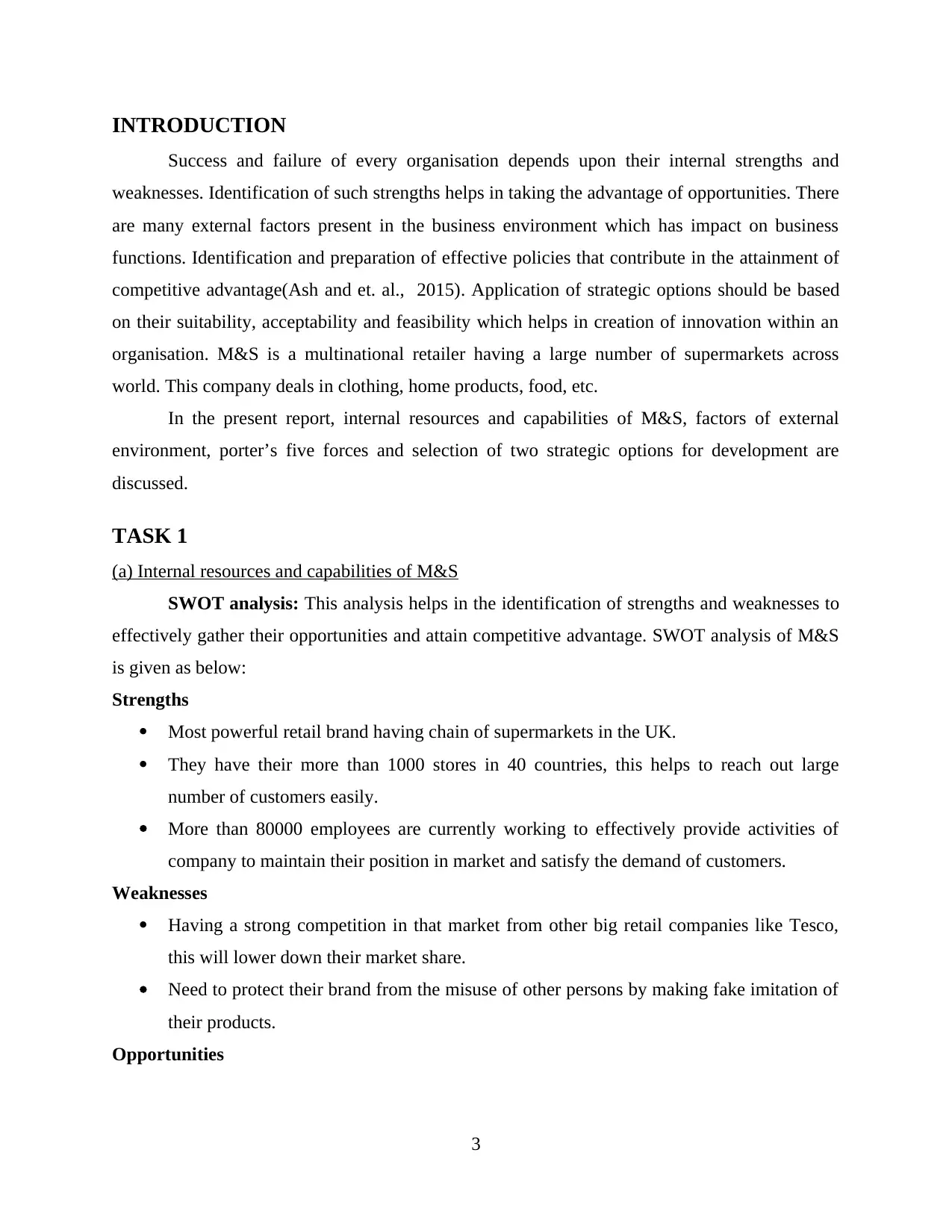
INTRODUCTION
Success and failure of every organisation depends upon their internal strengths and
weaknesses. Identification of such strengths helps in taking the advantage of opportunities. There
are many external factors present in the business environment which has impact on business
functions. Identification and preparation of effective policies that contribute in the attainment of
competitive advantage(Ash and et. al., 2015). Application of strategic options should be based
on their suitability, acceptability and feasibility which helps in creation of innovation within an
organisation. M&S is a multinational retailer having a large number of supermarkets across
world. This company deals in clothing, home products, food, etc.
In the present report, internal resources and capabilities of M&S, factors of external
environment, porter’s five forces and selection of two strategic options for development are
discussed.
TASK 1
(a) Internal resources and capabilities of M&S
SWOT analysis: This analysis helps in the identification of strengths and weaknesses to
effectively gather their opportunities and attain competitive advantage. SWOT analysis of M&S
is given as below:
Strengths
Most powerful retail brand having chain of supermarkets in the UK.
They have their more than 1000 stores in 40 countries, this helps to reach out large
number of customers easily.
More than 80000 employees are currently working to effectively provide activities of
company to maintain their position in market and satisfy the demand of customers.
Weaknesses
Having a strong competition in that market from other big retail companies like Tesco,
this will lower down their market share.
Need to protect their brand from the misuse of other persons by making fake imitation of
their products.
Opportunities
3
Success and failure of every organisation depends upon their internal strengths and
weaknesses. Identification of such strengths helps in taking the advantage of opportunities. There
are many external factors present in the business environment which has impact on business
functions. Identification and preparation of effective policies that contribute in the attainment of
competitive advantage(Ash and et. al., 2015). Application of strategic options should be based
on their suitability, acceptability and feasibility which helps in creation of innovation within an
organisation. M&S is a multinational retailer having a large number of supermarkets across
world. This company deals in clothing, home products, food, etc.
In the present report, internal resources and capabilities of M&S, factors of external
environment, porter’s five forces and selection of two strategic options for development are
discussed.
TASK 1
(a) Internal resources and capabilities of M&S
SWOT analysis: This analysis helps in the identification of strengths and weaknesses to
effectively gather their opportunities and attain competitive advantage. SWOT analysis of M&S
is given as below:
Strengths
Most powerful retail brand having chain of supermarkets in the UK.
They have their more than 1000 stores in 40 countries, this helps to reach out large
number of customers easily.
More than 80000 employees are currently working to effectively provide activities of
company to maintain their position in market and satisfy the demand of customers.
Weaknesses
Having a strong competition in that market from other big retail companies like Tesco,
this will lower down their market share.
Need to protect their brand from the misuse of other persons by making fake imitation of
their products.
Opportunities
3
⊘ This is a preview!⊘
Do you want full access?
Subscribe today to unlock all pages.

Trusted by 1+ million students worldwide
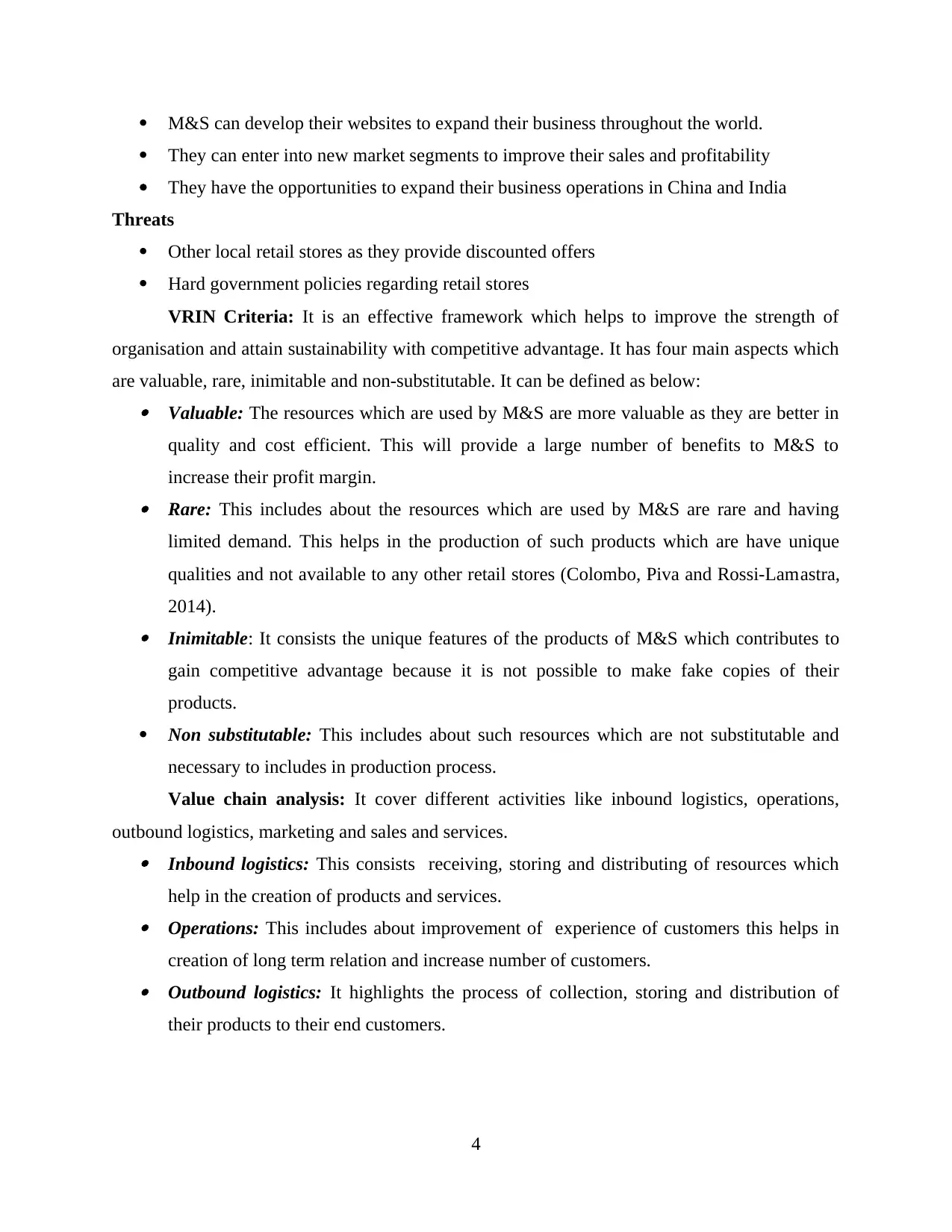
M&S can develop their websites to expand their business throughout the world.
They can enter into new market segments to improve their sales and profitability
They have the opportunities to expand their business operations in China and India
Threats
Other local retail stores as they provide discounted offers
Hard government policies regarding retail stores
VRIN Criteria: It is an effective framework which helps to improve the strength of
organisation and attain sustainability with competitive advantage. It has four main aspects which
are valuable, rare, inimitable and non-substitutable. It can be defined as below: Valuable: The resources which are used by M&S are more valuable as they are better in
quality and cost efficient. This will provide a large number of benefits to M&S to
increase their profit margin. Rare: This includes about the resources which are used by M&S are rare and having
limited demand. This helps in the production of such products which are have unique
qualities and not available to any other retail stores (Colombo, Piva and Rossi-Lamastra,
2014). Inimitable: It consists the unique features of the products of M&S which contributes to
gain competitive advantage because it is not possible to make fake copies of their
products.
Non substitutable: This includes about such resources which are not substitutable and
necessary to includes in production process.
Value chain analysis: It cover different activities like inbound logistics, operations,
outbound logistics, marketing and sales and services. Inbound logistics: This consists receiving, storing and distributing of resources which
help in the creation of products and services. Operations: This includes about improvement of experience of customers this helps in
creation of long term relation and increase number of customers. Outbound logistics: It highlights the process of collection, storing and distribution of
their products to their end customers.
4
They can enter into new market segments to improve their sales and profitability
They have the opportunities to expand their business operations in China and India
Threats
Other local retail stores as they provide discounted offers
Hard government policies regarding retail stores
VRIN Criteria: It is an effective framework which helps to improve the strength of
organisation and attain sustainability with competitive advantage. It has four main aspects which
are valuable, rare, inimitable and non-substitutable. It can be defined as below: Valuable: The resources which are used by M&S are more valuable as they are better in
quality and cost efficient. This will provide a large number of benefits to M&S to
increase their profit margin. Rare: This includes about the resources which are used by M&S are rare and having
limited demand. This helps in the production of such products which are have unique
qualities and not available to any other retail stores (Colombo, Piva and Rossi-Lamastra,
2014). Inimitable: It consists the unique features of the products of M&S which contributes to
gain competitive advantage because it is not possible to make fake copies of their
products.
Non substitutable: This includes about such resources which are not substitutable and
necessary to includes in production process.
Value chain analysis: It cover different activities like inbound logistics, operations,
outbound logistics, marketing and sales and services. Inbound logistics: This consists receiving, storing and distributing of resources which
help in the creation of products and services. Operations: This includes about improvement of experience of customers this helps in
creation of long term relation and increase number of customers. Outbound logistics: It highlights the process of collection, storing and distribution of
their products to their end customers.
4
Paraphrase This Document
Need a fresh take? Get an instant paraphrase of this document with our AI Paraphraser
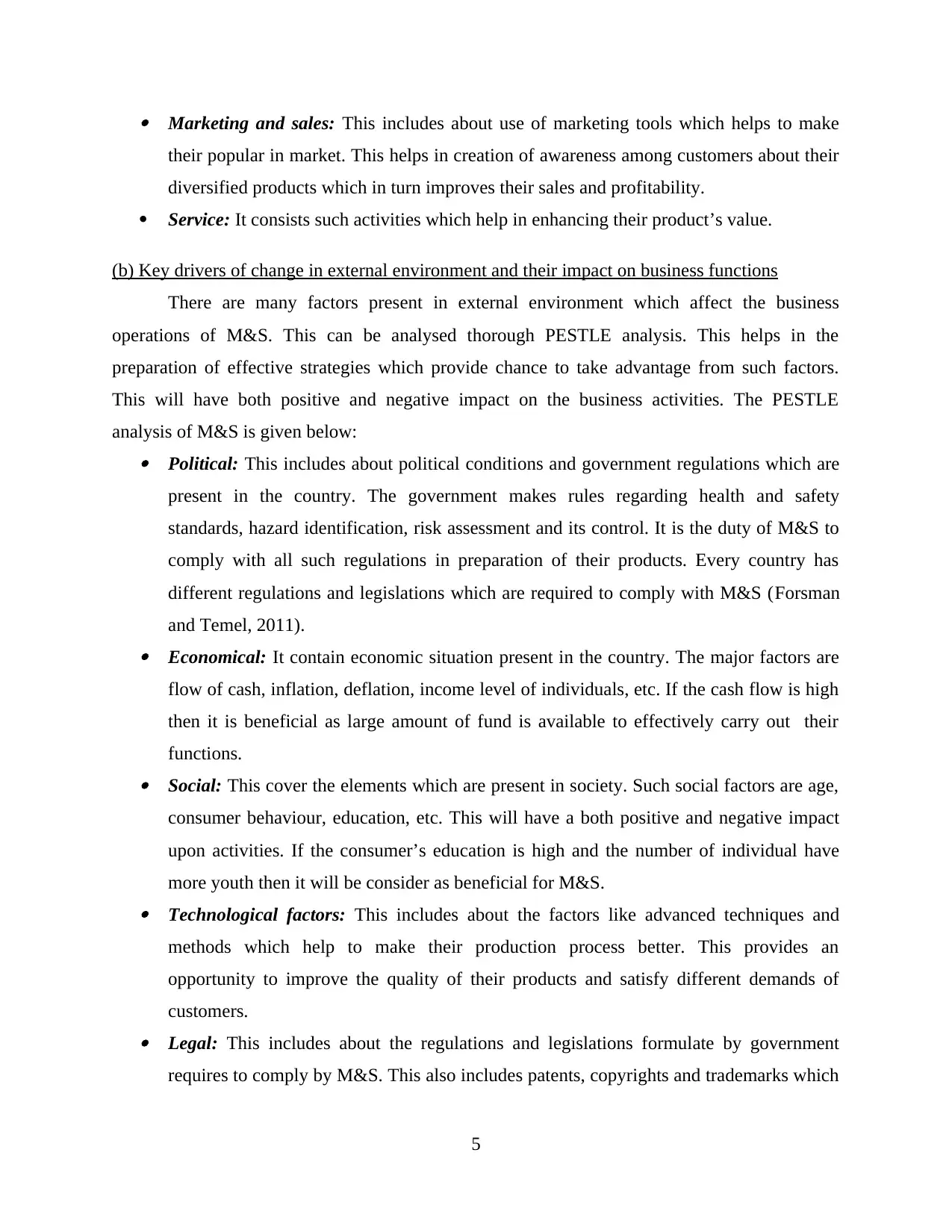
Marketing and sales: This includes about use of marketing tools which helps to make
their popular in market. This helps in creation of awareness among customers about their
diversified products which in turn improves their sales and profitability.
Service: It consists such activities which help in enhancing their product’s value.
(b) Key drivers of change in external environment and their impact on business functions
There are many factors present in external environment which affect the business
operations of M&S. This can be analysed thorough PESTLE analysis. This helps in the
preparation of effective strategies which provide chance to take advantage from such factors.
This will have both positive and negative impact on the business activities. The PESTLE
analysis of M&S is given below: Political: This includes about political conditions and government regulations which are
present in the country. The government makes rules regarding health and safety
standards, hazard identification, risk assessment and its control. It is the duty of M&S to
comply with all such regulations in preparation of their products. Every country has
different regulations and legislations which are required to comply with M&S (Forsman
and Temel, 2011). Economical: It contain economic situation present in the country. The major factors are
flow of cash, inflation, deflation, income level of individuals, etc. If the cash flow is high
then it is beneficial as large amount of fund is available to effectively carry out their
functions. Social: This cover the elements which are present in society. Such social factors are age,
consumer behaviour, education, etc. This will have a both positive and negative impact
upon activities. If the consumer’s education is high and the number of individual have
more youth then it will be consider as beneficial for M&S. Technological factors: This includes about the factors like advanced techniques and
methods which help to make their production process better. This provides an
opportunity to improve the quality of their products and satisfy different demands of
customers. Legal: This includes about the regulations and legislations formulate by government
requires to comply by M&S. This also includes patents, copyrights and trademarks which
5
their popular in market. This helps in creation of awareness among customers about their
diversified products which in turn improves their sales and profitability.
Service: It consists such activities which help in enhancing their product’s value.
(b) Key drivers of change in external environment and their impact on business functions
There are many factors present in external environment which affect the business
operations of M&S. This can be analysed thorough PESTLE analysis. This helps in the
preparation of effective strategies which provide chance to take advantage from such factors.
This will have both positive and negative impact on the business activities. The PESTLE
analysis of M&S is given below: Political: This includes about political conditions and government regulations which are
present in the country. The government makes rules regarding health and safety
standards, hazard identification, risk assessment and its control. It is the duty of M&S to
comply with all such regulations in preparation of their products. Every country has
different regulations and legislations which are required to comply with M&S (Forsman
and Temel, 2011). Economical: It contain economic situation present in the country. The major factors are
flow of cash, inflation, deflation, income level of individuals, etc. If the cash flow is high
then it is beneficial as large amount of fund is available to effectively carry out their
functions. Social: This cover the elements which are present in society. Such social factors are age,
consumer behaviour, education, etc. This will have a both positive and negative impact
upon activities. If the consumer’s education is high and the number of individual have
more youth then it will be consider as beneficial for M&S. Technological factors: This includes about the factors like advanced techniques and
methods which help to make their production process better. This provides an
opportunity to improve the quality of their products and satisfy different demands of
customers. Legal: This includes about the regulations and legislations formulate by government
requires to comply by M&S. This also includes patents, copyrights and trademarks which
5
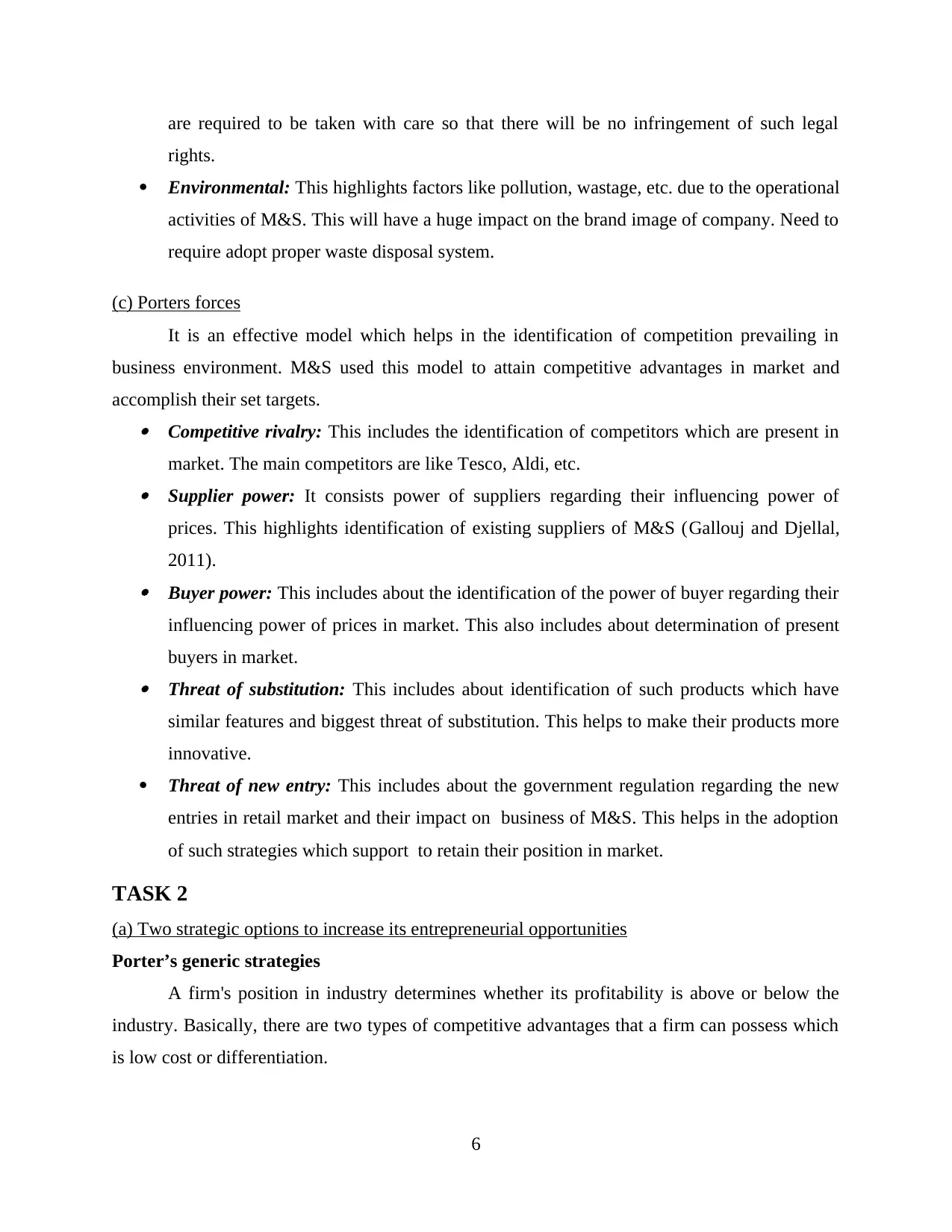
are required to be taken with care so that there will be no infringement of such legal
rights.
Environmental: This highlights factors like pollution, wastage, etc. due to the operational
activities of M&S. This will have a huge impact on the brand image of company. Need to
require adopt proper waste disposal system.
(c) Porters forces
It is an effective model which helps in the identification of competition prevailing in
business environment. M&S used this model to attain competitive advantages in market and
accomplish their set targets. Competitive rivalry: This includes the identification of competitors which are present in
market. The main competitors are like Tesco, Aldi, etc. Supplier power: It consists power of suppliers regarding their influencing power of
prices. This highlights identification of existing suppliers of M&S (Gallouj and Djellal,
2011). Buyer power: This includes about the identification of the power of buyer regarding their
influencing power of prices in market. This also includes about determination of present
buyers in market. Threat of substitution: This includes about identification of such products which have
similar features and biggest threat of substitution. This helps to make their products more
innovative.
Threat of new entry: This includes about the government regulation regarding the new
entries in retail market and their impact on business of M&S. This helps in the adoption
of such strategies which support to retain their position in market.
TASK 2
(a) Two strategic options to increase its entrepreneurial opportunities
Porter’s generic strategies
A firm's position in industry determines whether its profitability is above or below the
industry. Basically, there are two types of competitive advantages that a firm can possess which
is low cost or differentiation.
6
rights.
Environmental: This highlights factors like pollution, wastage, etc. due to the operational
activities of M&S. This will have a huge impact on the brand image of company. Need to
require adopt proper waste disposal system.
(c) Porters forces
It is an effective model which helps in the identification of competition prevailing in
business environment. M&S used this model to attain competitive advantages in market and
accomplish their set targets. Competitive rivalry: This includes the identification of competitors which are present in
market. The main competitors are like Tesco, Aldi, etc. Supplier power: It consists power of suppliers regarding their influencing power of
prices. This highlights identification of existing suppliers of M&S (Gallouj and Djellal,
2011). Buyer power: This includes about the identification of the power of buyer regarding their
influencing power of prices in market. This also includes about determination of present
buyers in market. Threat of substitution: This includes about identification of such products which have
similar features and biggest threat of substitution. This helps to make their products more
innovative.
Threat of new entry: This includes about the government regulation regarding the new
entries in retail market and their impact on business of M&S. This helps in the adoption
of such strategies which support to retain their position in market.
TASK 2
(a) Two strategic options to increase its entrepreneurial opportunities
Porter’s generic strategies
A firm's position in industry determines whether its profitability is above or below the
industry. Basically, there are two types of competitive advantages that a firm can possess which
is low cost or differentiation.
6
⊘ This is a preview!⊘
Do you want full access?
Subscribe today to unlock all pages.

Trusted by 1+ million students worldwide
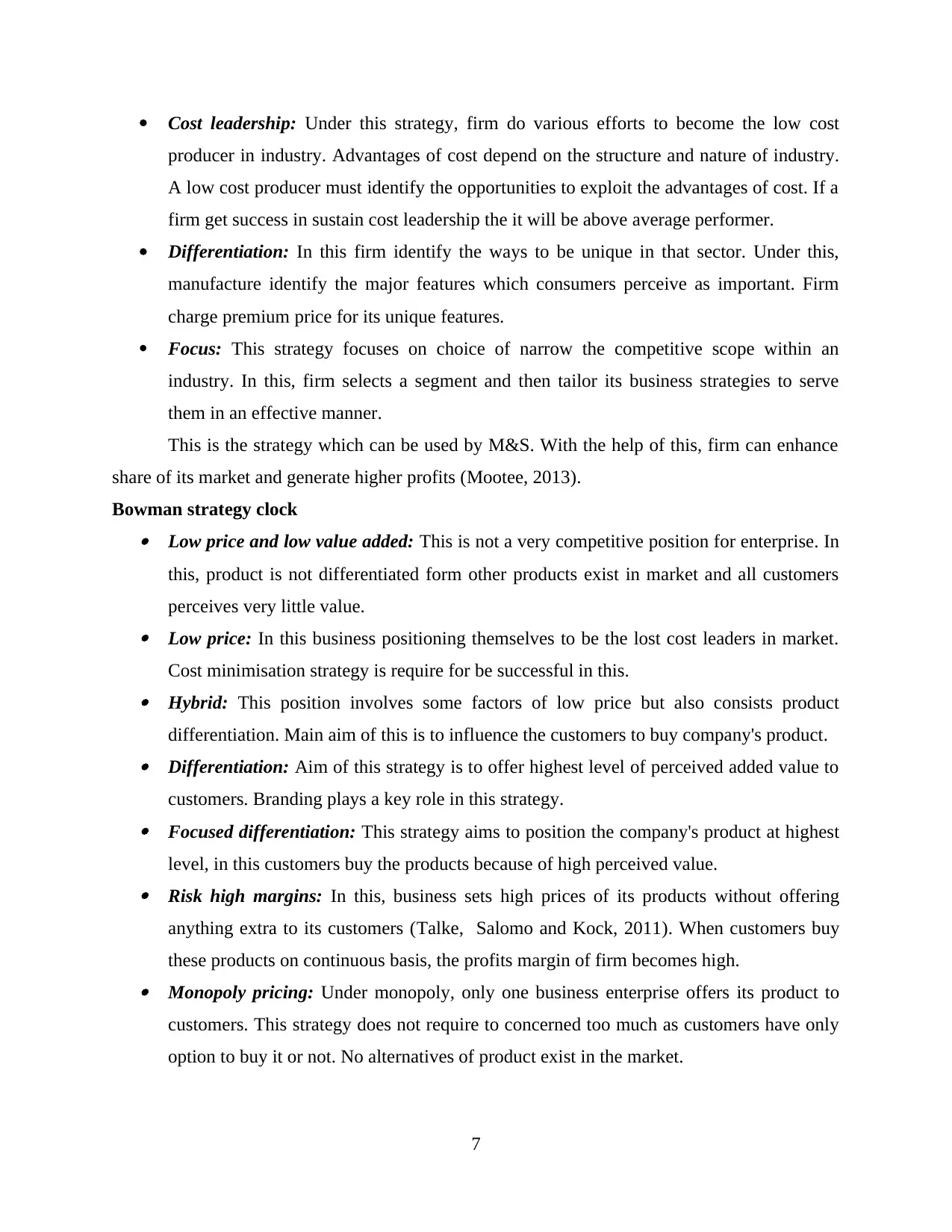
Cost leadership: Under this strategy, firm do various efforts to become the low cost
producer in industry. Advantages of cost depend on the structure and nature of industry.
A low cost producer must identify the opportunities to exploit the advantages of cost. If a
firm get success in sustain cost leadership the it will be above average performer.
Differentiation: In this firm identify the ways to be unique in that sector. Under this,
manufacture identify the major features which consumers perceive as important. Firm
charge premium price for its unique features.
Focus: This strategy focuses on choice of narrow the competitive scope within an
industry. In this, firm selects a segment and then tailor its business strategies to serve
them in an effective manner.
This is the strategy which can be used by M&S. With the help of this, firm can enhance
share of its market and generate higher profits (Mootee, 2013).
Bowman strategy clock Low price and low value added: This is not a very competitive position for enterprise. In
this, product is not differentiated form other products exist in market and all customers
perceives very little value. Low price: In this business positioning themselves to be the lost cost leaders in market.
Cost minimisation strategy is require for be successful in this. Hybrid: This position involves some factors of low price but also consists product
differentiation. Main aim of this is to influence the customers to buy company's product. Differentiation: Aim of this strategy is to offer highest level of perceived added value to
customers. Branding plays a key role in this strategy. Focused differentiation: This strategy aims to position the company's product at highest
level, in this customers buy the products because of high perceived value. Risk high margins: In this, business sets high prices of its products without offering
anything extra to its customers (Talke, Salomo and Kock, 2011). When customers buy
these products on continuous basis, the profits margin of firm becomes high. Monopoly pricing: Under monopoly, only one business enterprise offers its product to
customers. This strategy does not require to concerned too much as customers have only
option to buy it or not. No alternatives of product exist in the market.
7
producer in industry. Advantages of cost depend on the structure and nature of industry.
A low cost producer must identify the opportunities to exploit the advantages of cost. If a
firm get success in sustain cost leadership the it will be above average performer.
Differentiation: In this firm identify the ways to be unique in that sector. Under this,
manufacture identify the major features which consumers perceive as important. Firm
charge premium price for its unique features.
Focus: This strategy focuses on choice of narrow the competitive scope within an
industry. In this, firm selects a segment and then tailor its business strategies to serve
them in an effective manner.
This is the strategy which can be used by M&S. With the help of this, firm can enhance
share of its market and generate higher profits (Mootee, 2013).
Bowman strategy clock Low price and low value added: This is not a very competitive position for enterprise. In
this, product is not differentiated form other products exist in market and all customers
perceives very little value. Low price: In this business positioning themselves to be the lost cost leaders in market.
Cost minimisation strategy is require for be successful in this. Hybrid: This position involves some factors of low price but also consists product
differentiation. Main aim of this is to influence the customers to buy company's product. Differentiation: Aim of this strategy is to offer highest level of perceived added value to
customers. Branding plays a key role in this strategy. Focused differentiation: This strategy aims to position the company's product at highest
level, in this customers buy the products because of high perceived value. Risk high margins: In this, business sets high prices of its products without offering
anything extra to its customers (Talke, Salomo and Kock, 2011). When customers buy
these products on continuous basis, the profits margin of firm becomes high. Monopoly pricing: Under monopoly, only one business enterprise offers its product to
customers. This strategy does not require to concerned too much as customers have only
option to buy it or not. No alternatives of product exist in the market.
7
Paraphrase This Document
Need a fresh take? Get an instant paraphrase of this document with our AI Paraphraser
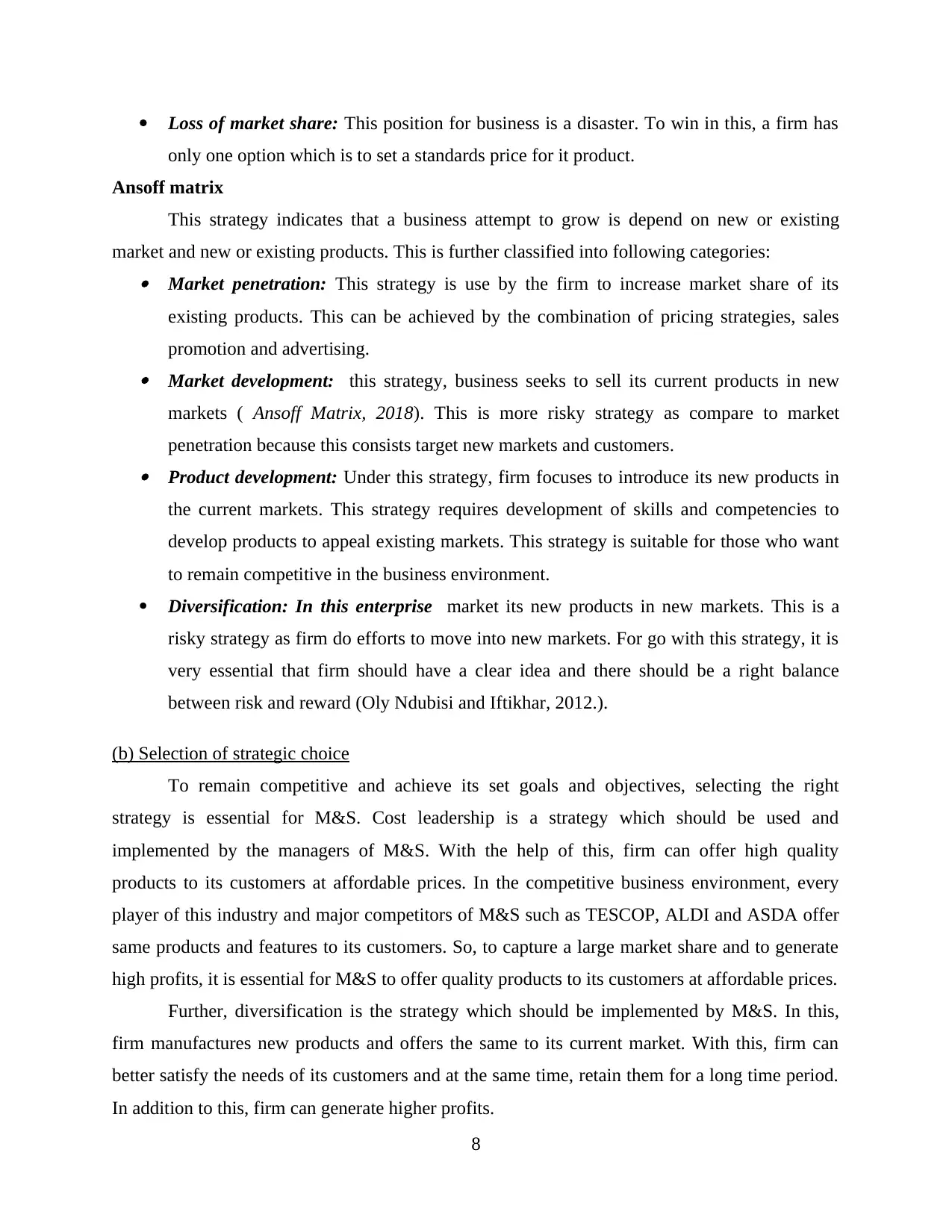
Loss of market share: This position for business is a disaster. To win in this, a firm has
only one option which is to set a standards price for it product.
Ansoff matrix
This strategy indicates that a business attempt to grow is depend on new or existing
market and new or existing products. This is further classified into following categories: Market penetration: This strategy is use by the firm to increase market share of its
existing products. This can be achieved by the combination of pricing strategies, sales
promotion and advertising. Market development: this strategy, business seeks to sell its current products in new
markets ( Ansoff Matrix, 2018). This is more risky strategy as compare to market
penetration because this consists target new markets and customers. Product development: Under this strategy, firm focuses to introduce its new products in
the current markets. This strategy requires development of skills and competencies to
develop products to appeal existing markets. This strategy is suitable for those who want
to remain competitive in the business environment.
Diversification: In this enterprise market its new products in new markets. This is a
risky strategy as firm do efforts to move into new markets. For go with this strategy, it is
very essential that firm should have a clear idea and there should be a right balance
between risk and reward (Oly Ndubisi and Iftikhar, 2012.).
(b) Selection of strategic choice
To remain competitive and achieve its set goals and objectives, selecting the right
strategy is essential for M&S. Cost leadership is a strategy which should be used and
implemented by the managers of M&S. With the help of this, firm can offer high quality
products to its customers at affordable prices. In the competitive business environment, every
player of this industry and major competitors of M&S such as TESCOP, ALDI and ASDA offer
same products and features to its customers. So, to capture a large market share and to generate
high profits, it is essential for M&S to offer quality products to its customers at affordable prices.
Further, diversification is the strategy which should be implemented by M&S. In this,
firm manufactures new products and offers the same to its current market. With this, firm can
better satisfy the needs of its customers and at the same time, retain them for a long time period.
In addition to this, firm can generate higher profits.
8
only one option which is to set a standards price for it product.
Ansoff matrix
This strategy indicates that a business attempt to grow is depend on new or existing
market and new or existing products. This is further classified into following categories: Market penetration: This strategy is use by the firm to increase market share of its
existing products. This can be achieved by the combination of pricing strategies, sales
promotion and advertising. Market development: this strategy, business seeks to sell its current products in new
markets ( Ansoff Matrix, 2018). This is more risky strategy as compare to market
penetration because this consists target new markets and customers. Product development: Under this strategy, firm focuses to introduce its new products in
the current markets. This strategy requires development of skills and competencies to
develop products to appeal existing markets. This strategy is suitable for those who want
to remain competitive in the business environment.
Diversification: In this enterprise market its new products in new markets. This is a
risky strategy as firm do efforts to move into new markets. For go with this strategy, it is
very essential that firm should have a clear idea and there should be a right balance
between risk and reward (Oly Ndubisi and Iftikhar, 2012.).
(b) Selection of strategic choice
To remain competitive and achieve its set goals and objectives, selecting the right
strategy is essential for M&S. Cost leadership is a strategy which should be used and
implemented by the managers of M&S. With the help of this, firm can offer high quality
products to its customers at affordable prices. In the competitive business environment, every
player of this industry and major competitors of M&S such as TESCOP, ALDI and ASDA offer
same products and features to its customers. So, to capture a large market share and to generate
high profits, it is essential for M&S to offer quality products to its customers at affordable prices.
Further, diversification is the strategy which should be implemented by M&S. In this,
firm manufactures new products and offers the same to its current market. With this, firm can
better satisfy the needs of its customers and at the same time, retain them for a long time period.
In addition to this, firm can generate higher profits.
8
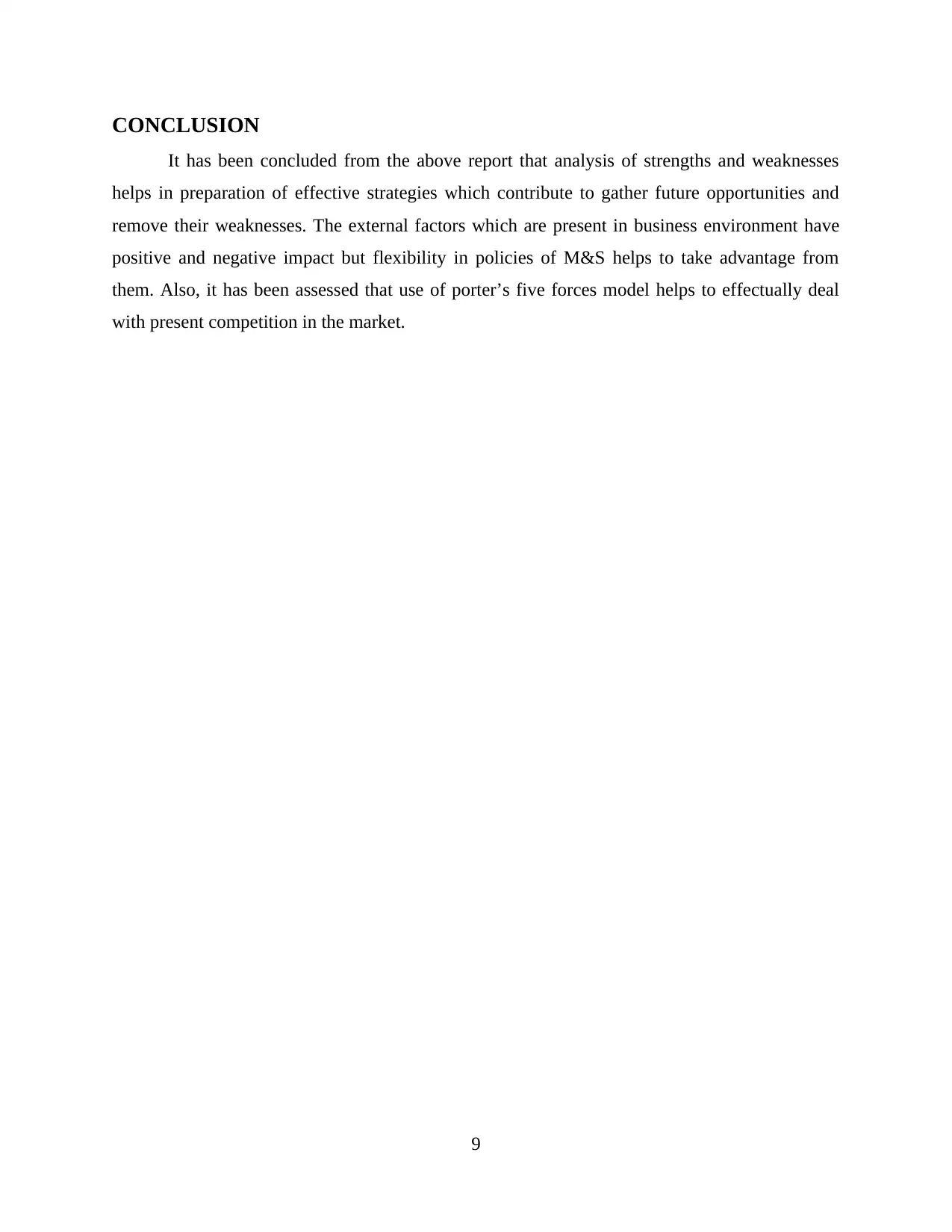
CONCLUSION
It has been concluded from the above report that analysis of strengths and weaknesses
helps in preparation of effective strategies which contribute to gather future opportunities and
remove their weaknesses. The external factors which are present in business environment have
positive and negative impact but flexibility in policies of M&S helps to take advantage from
them. Also, it has been assessed that use of porter’s five forces model helps to effectually deal
with present competition in the market.
9
It has been concluded from the above report that analysis of strengths and weaknesses
helps in preparation of effective strategies which contribute to gather future opportunities and
remove their weaknesses. The external factors which are present in business environment have
positive and negative impact but flexibility in policies of M&S helps to take advantage from
them. Also, it has been assessed that use of porter’s five forces model helps to effectually deal
with present competition in the market.
9
⊘ This is a preview!⊘
Do you want full access?
Subscribe today to unlock all pages.

Trusted by 1+ million students worldwide
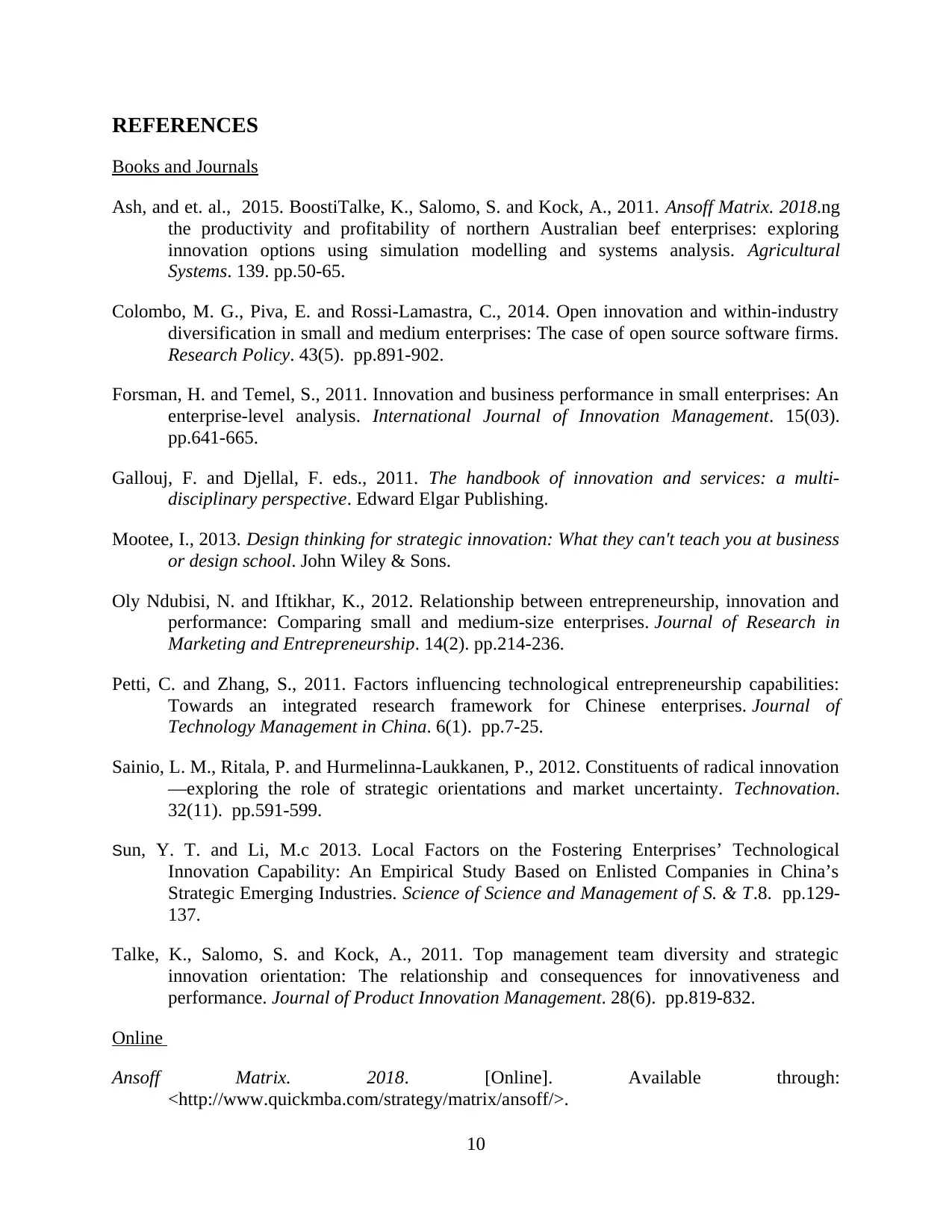
REFERENCES
Books and Journals
Ash, and et. al., 2015. BoostiTalke, K., Salomo, S. and Kock, A., 2011. Ansoff Matrix. 2018.ng
the productivity and profitability of northern Australian beef enterprises: exploring
innovation options using simulation modelling and systems analysis. Agricultural
Systems. 139. pp.50-65.
Colombo, M. G., Piva, E. and Rossi-Lamastra, C., 2014. Open innovation and within-industry
diversification in small and medium enterprises: The case of open source software firms.
Research Policy. 43(5). pp.891-902.
Forsman, H. and Temel, S., 2011. Innovation and business performance in small enterprises: An
enterprise-level analysis. International Journal of Innovation Management. 15(03).
pp.641-665.
Gallouj, F. and Djellal, F. eds., 2011. The handbook of innovation and services: a multi-
disciplinary perspective. Edward Elgar Publishing.
Mootee, I., 2013. Design thinking for strategic innovation: What they can't teach you at business
or design school. John Wiley & Sons.
Oly Ndubisi, N. and Iftikhar, K., 2012. Relationship between entrepreneurship, innovation and
performance: Comparing small and medium-size enterprises. Journal of Research in
Marketing and Entrepreneurship. 14(2). pp.214-236.
Petti, C. and Zhang, S., 2011. Factors influencing technological entrepreneurship capabilities:
Towards an integrated research framework for Chinese enterprises. Journal of
Technology Management in China. 6(1). pp.7-25.
Sainio, L. M., Ritala, P. and Hurmelinna-Laukkanen, P., 2012. Constituents of radical innovation
—exploring the role of strategic orientations and market uncertainty. Technovation.
32(11). pp.591-599.
Sun, Y. T. and Li, M.c 2013. Local Factors on the Fostering Enterprises’ Technological
Innovation Capability: An Empirical Study Based on Enlisted Companies in China’s
Strategic Emerging Industries. Science of Science and Management of S. & T.8. pp.129-
137.
Talke, K., Salomo, S. and Kock, A., 2011. Top management team diversity and strategic
innovation orientation: The relationship and consequences for innovativeness and
performance. Journal of Product Innovation Management. 28(6). pp.819-832.
Online
Ansoff Matrix. 2018. [Online]. Available through:
<http://www.quickmba.com/strategy/matrix/ansoff/>.
10
Books and Journals
Ash, and et. al., 2015. BoostiTalke, K., Salomo, S. and Kock, A., 2011. Ansoff Matrix. 2018.ng
the productivity and profitability of northern Australian beef enterprises: exploring
innovation options using simulation modelling and systems analysis. Agricultural
Systems. 139. pp.50-65.
Colombo, M. G., Piva, E. and Rossi-Lamastra, C., 2014. Open innovation and within-industry
diversification in small and medium enterprises: The case of open source software firms.
Research Policy. 43(5). pp.891-902.
Forsman, H. and Temel, S., 2011. Innovation and business performance in small enterprises: An
enterprise-level analysis. International Journal of Innovation Management. 15(03).
pp.641-665.
Gallouj, F. and Djellal, F. eds., 2011. The handbook of innovation and services: a multi-
disciplinary perspective. Edward Elgar Publishing.
Mootee, I., 2013. Design thinking for strategic innovation: What they can't teach you at business
or design school. John Wiley & Sons.
Oly Ndubisi, N. and Iftikhar, K., 2012. Relationship between entrepreneurship, innovation and
performance: Comparing small and medium-size enterprises. Journal of Research in
Marketing and Entrepreneurship. 14(2). pp.214-236.
Petti, C. and Zhang, S., 2011. Factors influencing technological entrepreneurship capabilities:
Towards an integrated research framework for Chinese enterprises. Journal of
Technology Management in China. 6(1). pp.7-25.
Sainio, L. M., Ritala, P. and Hurmelinna-Laukkanen, P., 2012. Constituents of radical innovation
—exploring the role of strategic orientations and market uncertainty. Technovation.
32(11). pp.591-599.
Sun, Y. T. and Li, M.c 2013. Local Factors on the Fostering Enterprises’ Technological
Innovation Capability: An Empirical Study Based on Enlisted Companies in China’s
Strategic Emerging Industries. Science of Science and Management of S. & T.8. pp.129-
137.
Talke, K., Salomo, S. and Kock, A., 2011. Top management team diversity and strategic
innovation orientation: The relationship and consequences for innovativeness and
performance. Journal of Product Innovation Management. 28(6). pp.819-832.
Online
Ansoff Matrix. 2018. [Online]. Available through:
<http://www.quickmba.com/strategy/matrix/ansoff/>.
10
1 out of 10
Related Documents
Your All-in-One AI-Powered Toolkit for Academic Success.
+13062052269
info@desklib.com
Available 24*7 on WhatsApp / Email
![[object Object]](/_next/static/media/star-bottom.7253800d.svg)
Unlock your academic potential
Copyright © 2020–2025 A2Z Services. All Rights Reserved. Developed and managed by ZUCOL.





